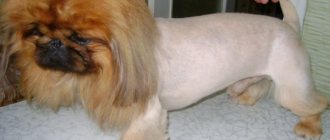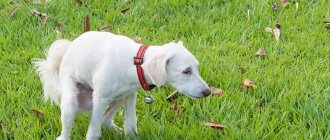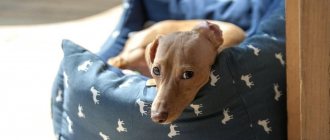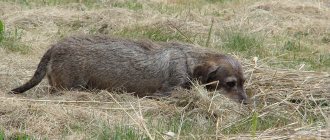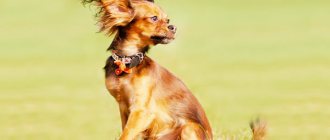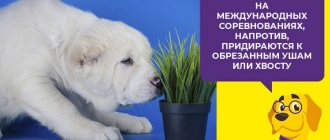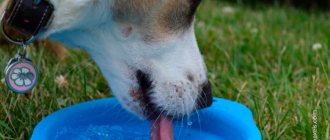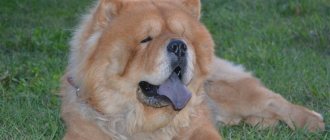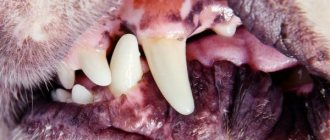The owner of the animal needs to know everything about what is volvulus in dogs: symptoms, signs, treatment. The fact is that this pathology is extremely dangerous for a pet and can lead to its death in a short time. Whether the dog will live or not depends on how quickly a person can navigate when such a problem arises.
Owners of animals of any age and any breed can face this danger. Increased risks of its occurrence exist in those pets who constantly overeat, eat low-quality food, and go for a walk immediately after lunch or dinner. Their condition must be monitored especially carefully in order to have time to provide emergency assistance to such an animal in an emergency.
What is volvulus?
This is a mechanical twisting of internal organs. This pathological condition provokes the development of sepsis and the death of the animal. If the animal does not receive medical assistance within 3-4 hours after its onset, it will die. There are several types of this pathology:
- Twisting of the mesentery, accompanied by compression of the artery. Because of this, the dog's blood flow is disrupted.
- Displacement of the lower intestine. This causes compression of the colon. This pathology provokes the accumulation of toxins in the body.
Other options for displacement of internal organs are possible, however, they are less common. Each of these types, regardless of the cause, can only be eliminated surgically. The owner of the animal needs to remember that if a volvulus is suspected, he should immediately take it to the veterinarian. Any attempts to help your pet on your own will only lead to his painful death.
Causes in animals
Pathology can be caused by various factors:
- Natural: the large size of the animal, the predisposition of the breed to this disease, chronic diseases of the gastrointestinal tract, including gastritis, ulcers. Volvulus can be triggered by the dog's excessive activity, constant jumping, and increased stress on the peritoneum. Also, pathology often occurs in animals that show fear and constant anxiety.
- Arising through the fault of the owners. These include irregular feeding, use of low-quality feed, frequent walks and exercise immediately after meals. Also, due to the fault of the owners, intestinal volvulus can be caused by severe stress caused by moving, scandals in the family, or frequent trips out of town.
Often, a pathological condition in an animal occurs under the influence of several factors at once, including constitutional predisposition, improper feeding, and excessive physical activity.
Symptoms of volvulus in dogs
This pathology usually manifests itself as follows:
- The animal's health deteriorates sharply. This usually happens immediately after eating or exercising. The dog stops playing, becomes restless, and may whine.
- The pet's belly increases.
- The dog is sick. In this case, there is no vomiting, since the twisted internal organs do not allow the vomit to leave the body.
A couple of hours after the animal’s condition worsens, a person may observe the following signs of volvulus in dogs:
- shortness of breath;
- pallor of mucous membranes;
- labored breathing;
- decrease in temperature;
- increased salivation.
The dog may show anxiety, roll over from side to side, choosing a comfortable position, and at times behave apathetically. In this state, he will not show interest in his favorite treats or games.
It should be noted that symptoms of volvulus in a dog can manifest themselves chaotically. You need to contact your veterinarian if you notice at least three of them.
Main symptoms
It is very easy to determine intestinal volvulus in your pet, since the pathology has a pronounced clinical picture regardless of which part of the gastrointestinal tract is affected. The disease is acute and progresses rapidly. The dog experiences severe wave-like pain of a spasmodic nature. She experiences constipation and uncontrollable vomiting with foam, during which the muscles of the upper peritoneum tense. The most striking symptom of volvulus is the tone of the muscles of the hind limbs. It’s hard for the dog to stand, so he tries to lie down and stretch out his paws. Upon palpation, you can feel a swollen intestine and a tight, swollen abdomen.
The temperature rises to 41 degrees. New symptoms appear: bluish skin, salivation, difficulty breathing.
Having noticed these signs, you cannot hesitate, otherwise the dog may die from acute sepsis. There is no more than 8 hours to save the animal, but we can only talk about a good prognosis if professional help was provided in the first 1-1.5 hours after the attack.
Diagnosis of the disease
To understand that a dog has a volvulus and not some other pathology, the veterinarian needs to conduct a comprehensive diagnosis. It provides:
- Interview with the pet owner. During this process, the doctor must find out how long ago the animal developed alarming symptoms, whether the animal has diseases that can give similar symptoms, and what contraindications it has to certain methods of treatment.
- General inspection.
- Ultrasound. Allows you to assess the condition of internal organs.
- Blood analysis.
Additional studies for suspected volvulus are usually not required. Having basic information about the animal’s condition, the doctor will be able to prescribe treatment and further care.
First aid for a pet
If a dog breeder manages to recognize volvulus in his pet, he needs to take the animal to the veterinarian as soon as possible. To alleviate your pet's condition, you can give him the following painkillers:
- Baralgin in a dosage of 0.1 ml of the drug per 1 kilogram of animal weight. The medicine is administered intramuscularly. The drug quickly relieves intense pain, but gives a short-lived effect.
- Ketonal at a dosage of 1 mg per kilogram of live weight. Allows you to alleviate your pet's condition for a day. It can be used if you live far from a veterinarian and cannot deliver your dog to him promptly.
- Carprofen. Used in a dosage of 0.2 mg per kilogram of weight, administered intramuscularly once a day. The medicine has a pronounced antipyretic and anti-edematous effect.
It is strictly forbidden to use the following medications to stabilize the animal’s condition:
- Activated carbon. In this case, it will simply get stuck in the pet's stomach.
- Laxative. Drugs of this type will only aggravate the pet’s condition, putting extra stress on the intestines.
- Vasoconstrictors. They do not give a pronounced effect due to the general disruption of the circulatory system during volvulus.
It is also prohibited to use any folk remedies to treat your pet: rubbing, herbal decoctions, lotions. Trying to help using such methods, the dog breeder will only waste precious time and increase the risk of death.
Treatment and surgery
With this pathology, drug therapy is powerless. It can only temporarily eliminate the symptoms, but will not save the pet. The only effective method of combating volvulus is surgery. The pet is prepared for it as follows:
- The dog is given antiemetic drugs. This is necessary so that the animal does not choke in vomit when entering or exiting anesthesia.
- They give steroid hormones, painkillers, and antispasmodics. They allow you to protect the animal from painful shock.
- The animal is put into medicated sleep.
After this, the veterinarian can begin surgery. It works like this:
- First, the doctor makes an incision in the abdominal wall and inserts a needle into it. This technique allows you to remove gases accumulated in the peritoneum. If this is not done, they will interfere with the operation.
- Next, the veterinarian moves the intestines into the correct position.
- After such manipulation, probing is carried out. During this procedure, food debris is removed from the stomach and intestines. Next, the doctor removes dead areas of the mucous membrane (if any).
- After this, the peritoneum is washed with an antiseptic solution so that pathogenic microorganisms do not multiply in it.
- At the last stage, the surgeon sews the stomach to the abdominal wall and completes the operation.
If you contact a veterinarian in a timely manner, the prognosis for the animal is positive. If the pet owner delays this issue, the latter may experience various complications. A fatal outcome cannot be ruled out.
Treatment of this disease
In the emergency situation of gastric volvulus in dogs, you should immediately take your pet to the veterinarian. If you don’t want to go to extreme measures, you can diagnose the disease based on a photo of an X-ray of the abdominal cavity.
The operation requires a certain preoperative set of procedures, including: infusion therapy, administration of analgesics and hormones, sedatives, antispasmodics and antiemetics. During the infusion process, the stomach is pierced with a large-diameter needle to reduce pressure on the abdominal cavity. Next, they begin the actual operation, during which the stomach is unfolded in order to get rid of feces from the stomach. This is followed by gastric lavage. The apogee of the operation is considered to be suturing the stomach to the wall of the abdomen so that it subsequently acquires its normal shape.
If part of the stomach becomes necrotic, you should get rid of it. In situations of parenchyma rupture, the spleen must also be removed. The rehabilitation period for a dog is two to three days of inpatient observation, during which it is injected with antibiotics and is not fed for a day after surgery.
Caring for your pet after surgery
After the end of the operation and recovery from anesthesia, the animal is left in the clinic for 4-5 days. There he is provided with:
- Treating the seam with antiseptic agents.
- Antibacterial therapy.
- Taking gastroprotectors and antiemetics.
- Parenteral feeding after volvulus surgery in dogs.
If the surgical intervention was successful, the pet will be discharged within 5 days after visiting the clinic. He will need to receive further treatment at home. It involves taking gastroprotectors, treating the suture, and taking vitamins. The dog will also need to be provided with complete rest, temporarily isolated from communication with other animals, and follow a diet. Periodically, your pet will need to be taken to the veterinarian. As soon as he is convinced that everything is fine with the animal, the doctor will allow him to return to his previous way of life.
Video: what is volvulus in dogs, its symptoms, signs, treatment
Preventive measures
Measures to prevent the disease can be called attention to your pet, since it is attentiveness to its diet, activity and rest regime that will be the key to preventing the disease. To minimize the risk of illness, you should adhere to certain rules. For example, it is worth feeding the animal often in small portions 2-3 times a day, and only with high-quality, easily digestible types of food. You should not overload your dog with physical activity, walk it, or force it to run after eating. Minimize stressful situations for your four-legged dog.
If symptoms occur, you should immediately contact your veterinarian. Delaying professional intervention in an emergency situation will shorten the pet’s life several times, even leading to death.
There is no less danger in the postoperative period - a period when the four-legged animal is extremely susceptible to pathogens. Therefore, to avoid complications, you should strictly follow all the veterinarian’s instructions. The main thing is to understand that whether it is hair loss or even volvulus in dogs, you are obliged to solve this problem. In this case, the classic phrase that comes to mind, painfully known to all pet owners, is that the owner is responsible for the one he has tamed.
Currently reading:
- Blindness is a faithful companion of entropion in a dog
- Symptoms and actions for abdominal cramps in a dog
- How to help a dog with intestinal obstruction
- Seven Signs and Remedies for Getting Rid of Fleas in Dogs
How to avoid volvulus in a dog?
In order not to encounter this pathology, the pet owner must follow simple preventive measures:
- Feed the animal at least 3 times a day. Give him food in small portions.
- Monitor your pet’s health, and if any signs of gastrointestinal diseases appear, immediately contact a veterinarian. Vaccinate the animal in a timely manner and carry out deworming.
- Be responsible when choosing food for your pet. Feed him exclusively high-quality feed, good natural food.
- Do not take the animal for a walk immediately after eating. You need to wait at least an hour after your next meal or do a workout half an hour before it.
It should be noted that implementation of the presented measures is not a 100% guarantee of protection against volvulus. But it can significantly reduce such risks. In addition, compliance with the presented preventive recommendations will allow the dog breeder to avoid various gastrointestinal diseases that have similar causes and similar symptoms.
Prevention measures
Like any other disease, volvulus can be prevented by using certain preventive measures. They mainly relate to nutrition, which should be given special attention. The dog should eat strictly twice a day at the same time. The diet is balanced, with a predominance of bone meal, meat, enriched with calcium.
You need to feed your dog after a walk, not before a walk.
If suspicious signs indicating a volvulus appear, you need to inject the dog with an anesthetic and take it to a veterinary clinic as soon as possible.
